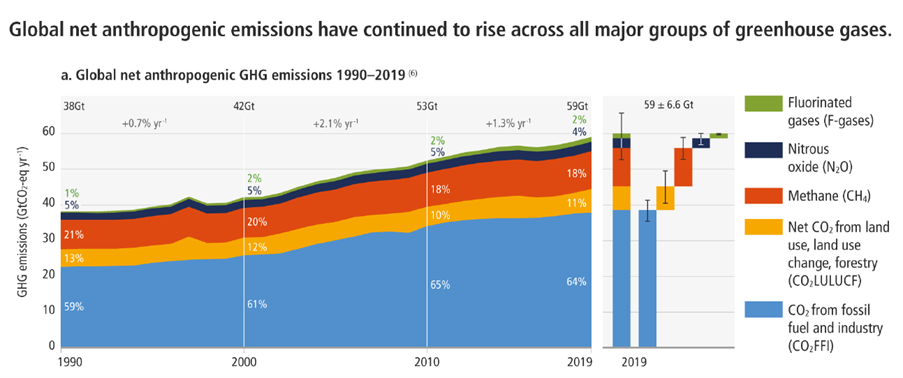IPCC Report: Low GWP refrigerants, including HFOs, can contribute to climate change mitigation
The IPCC AR6 report, “Climate Change 2022: Mitigation of Climate Change,” comments on how low GWP refrigerants, which includes HFOs, together with reduced energy demand and improved energy efficiency can contribute to climate change mitigation. Here are some important points relevant to HFCs and HFOs. The full report, technical summary and summary for policy makers are available from: https://www.ipcc.ch/report/ar6/wg3/.
F-Gases (HFCs, PFCs and SF6) contributed about 2% to anthropogenic GHG (greenhouse gases) emissions in 2019, about the same percentage as in 2000 and 2010, although F-gas emissions have increased considerably due to the replacement of Ozone Depleting Substances by HFCs. Average annual GHG emissions during 2010-2019 were higher than in any previous decade, but the rate of growth between 2010 and 2019 was lower than that between 2000 and 2009.

Full compliance with the Kigali Amendment is predicted to reduce HFC emissions by 61% of the global baseline by 2050, with avoided global warming in 2100 due to HFCs from a baseline of 0.3-0.5°C to less than 0.1°C. However, achievement of the objectives of the Kigali Amendment is dependent on its ratification by key developed countries, such as the United States, and the provision of funds by developed countries through the Protocol’s Multilateral Fund to meet developing countries agreed incremental costs of implementation.
The rapid phase-down of HFCs under the Kigali Amendment is possible because of extensive replacement of high-global warming potential (GWP) HFCs with commercially available low-GWP alternatives in refrigeration and air-conditioning equipment. Each country’s choices of alternative refrigerants will likely be determined by energy efficiency, costs, and refrigerant toxicity and flammability. National and regional regulations will be needed to drive technological innovation and development.
Cooling energy demand: in a warming world with a growing population and expanding middle-class, the demand for cooling is likely to increase emissions if cooling solutions implemented are carbon intensive. Sufficiency measures such as building design and forms, which allow balancing the size of openings, the volume, the wall and window area, the thermal properties, shading, and orientation are all non-cost solutions, which should be considered first to reduce cooling demand. The installation of highly efficient technological solutions with low Global Warming Potential (GWP), as part of the implementation of the Kigali amendment to the Montreal Protocol, is the second step towards reducing GHG emissions from cooling.
Efficient buildings, cooler in summer, warmer in winter, towards net zero energy: most accelerated mitigation pathway scenarios include significant increase in building energy efficiency. Countries in cold regions, in particular, often focus more on building sector GHG emissions mitigation measures such as improving building envelopes and home appliances, and electrifying space heating and water heating. For the EU to reach net carbon neutrality, complete substitution of fossil fuels with electricity (up to 65% share), district heating, and direct use of solar and ambient heat are projected to be needed for buildings, along with increased use of solar thermal and heat pumps for heating.
Food systems, storage and distribution: refrigeration uses an estimated 43% of energy in the retail sector and significantly increases fuel consumption during distribution. Besides being energy intensive, supermarket refrigeration also contributes to GHG emissions through leakage of refrigerants (F-gases), although their contribution to food system GHG emissions is estimated to be minor. A trade-off exists between reducing food waste and increased refrigeration emissions, with the benefits depending on type of produce, location and technologies used. Efficient refrigeration options include advanced refrigeration temperature control systems, and installation of more efficient refrigerators, air curtains and closed display fridges. Also related to reducing emissions from cooling and refrigeration is the replacement of hydrofluorocarbons which have very high GWPs with lower GWP alternatives.
Image: ©IPCC AR6 report